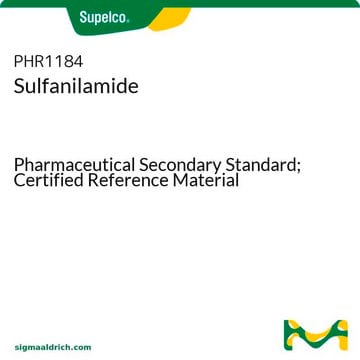1632004
USP
Sulfanilamide
United States Pharmacopeia (USP) Reference Standard
Synonim(y):
p-Aminobenzenesulfonamide
About This Item
Polecane produkty
klasa czystości
pharmaceutical primary standard
rodzina API
sulfanilamide
producent / nazwa handlowa
USP
mp
164-166 °C (lit.)
Zastosowanie
pharmaceutical (small molecule)
format
neat
ciąg SMILES
Nc1ccc(cc1)S(N)(=O)=O
InChI
1S/C6H8N2O2S/c7-5-1-3-6(4-2-5)11(8,9)10/h1-4H,7H2,(H2,8,9,10)
Klucz InChI
FDDDEECHVMSUSB-UHFFFAOYSA-N
Szukasz podobnych produktów? Odwiedź Przewodnik dotyczący porównywania produktów
Opis ogólny
Zastosowanie
- Silver Sulfadiazine
- Sulfacetamide Sodium
- Sulfamethoxazole
- Sulfamethoxazole and Trimethoprim Injection
Komentarz do analizy
Inne uwagi
produkt powiązany
Kod klasy składowania
11 - Combustible Solids
Klasa zagrożenia wodnego (WGK)
WGK 1
Temperatura zapłonu (°F)
Not applicable
Temperatura zapłonu (°C)
Not applicable
Certyfikaty analizy (CoA)
Poszukaj Certyfikaty analizy (CoA), wpisując numer partii/serii produktów. Numery serii i partii można znaleźć na etykiecie produktu po słowach „seria” lub „partia”.
Masz już ten produkt?
Dokumenty związane z niedawno zakupionymi produktami zostały zamieszczone w Bibliotece dokumentów.
Klienci oglądali również te produkty
Nasz zespół naukowców ma doświadczenie we wszystkich obszarach badań, w tym w naukach przyrodniczych, materiałoznawstwie, syntezie chemicznej, chromatografii, analityce i wielu innych dziedzinach.
Skontaktuj się z zespołem ds. pomocy technicznej









